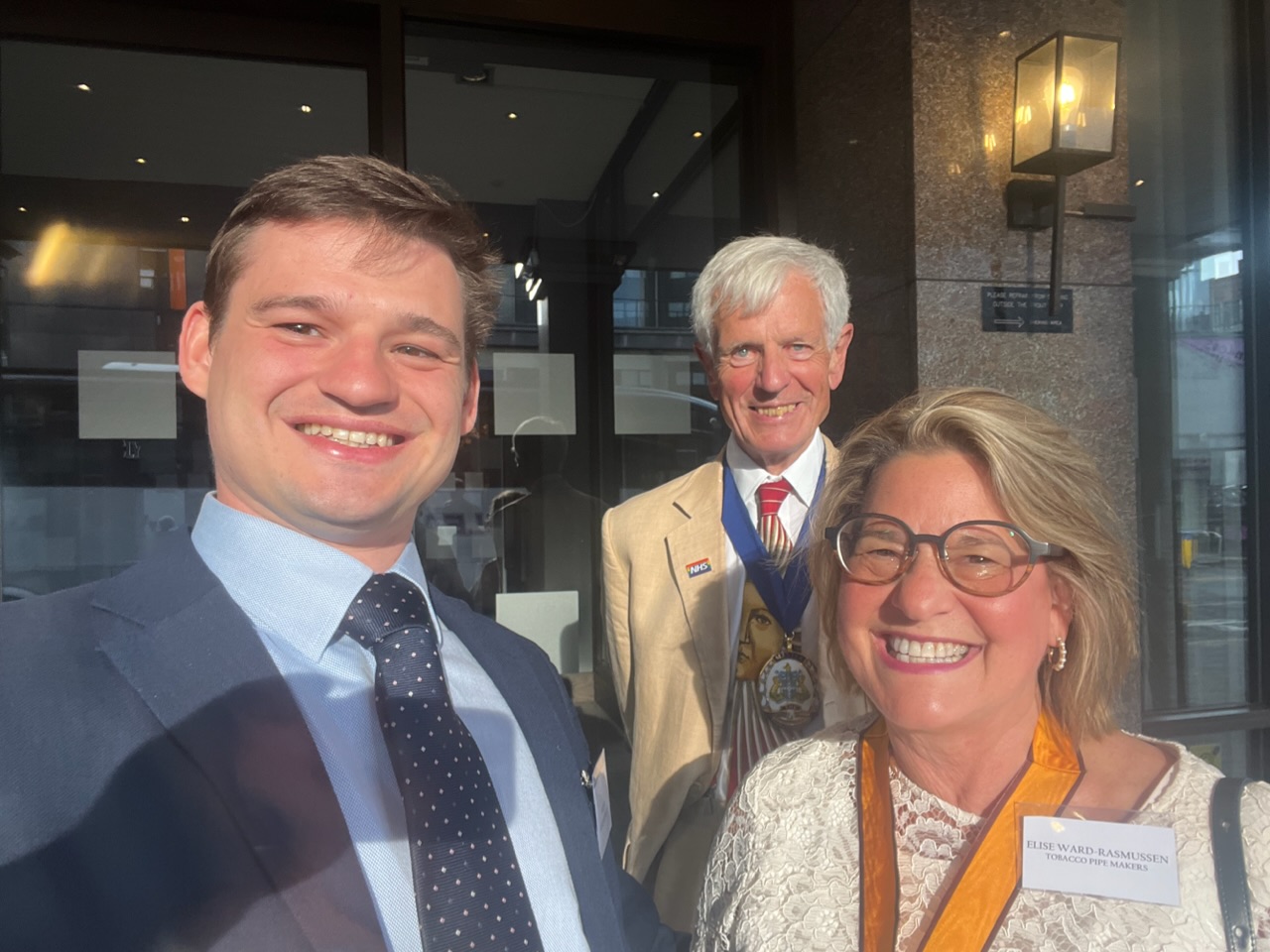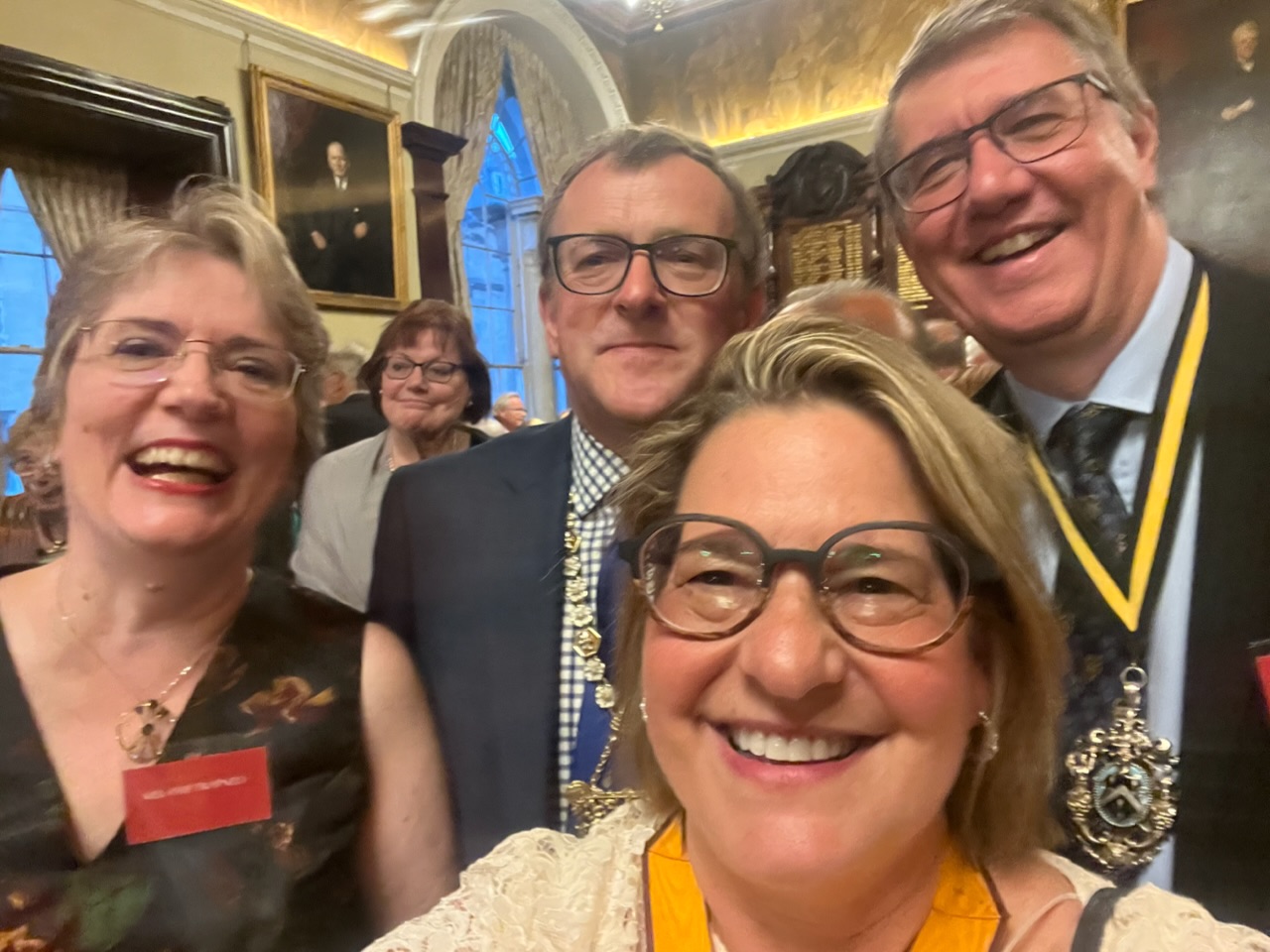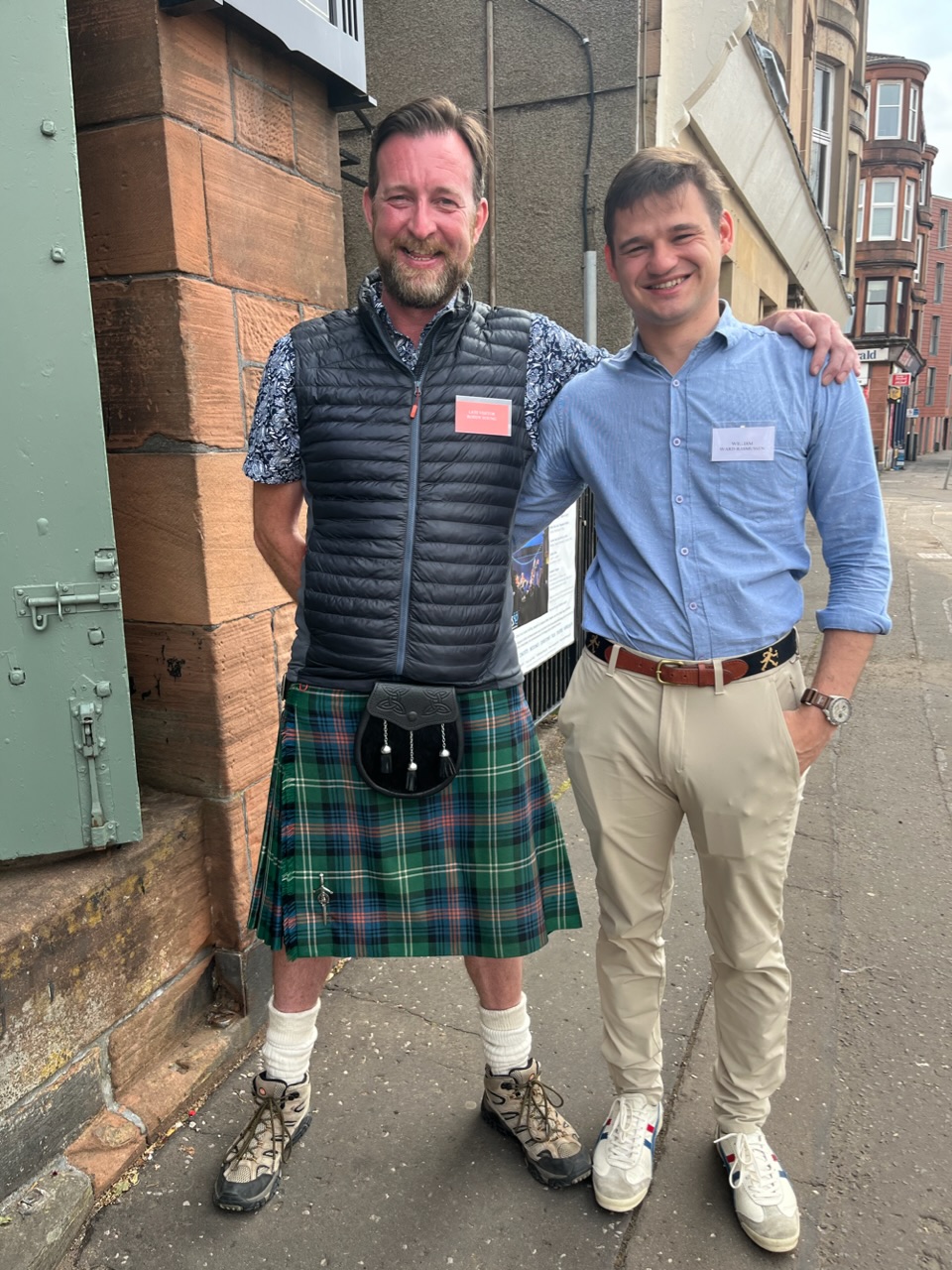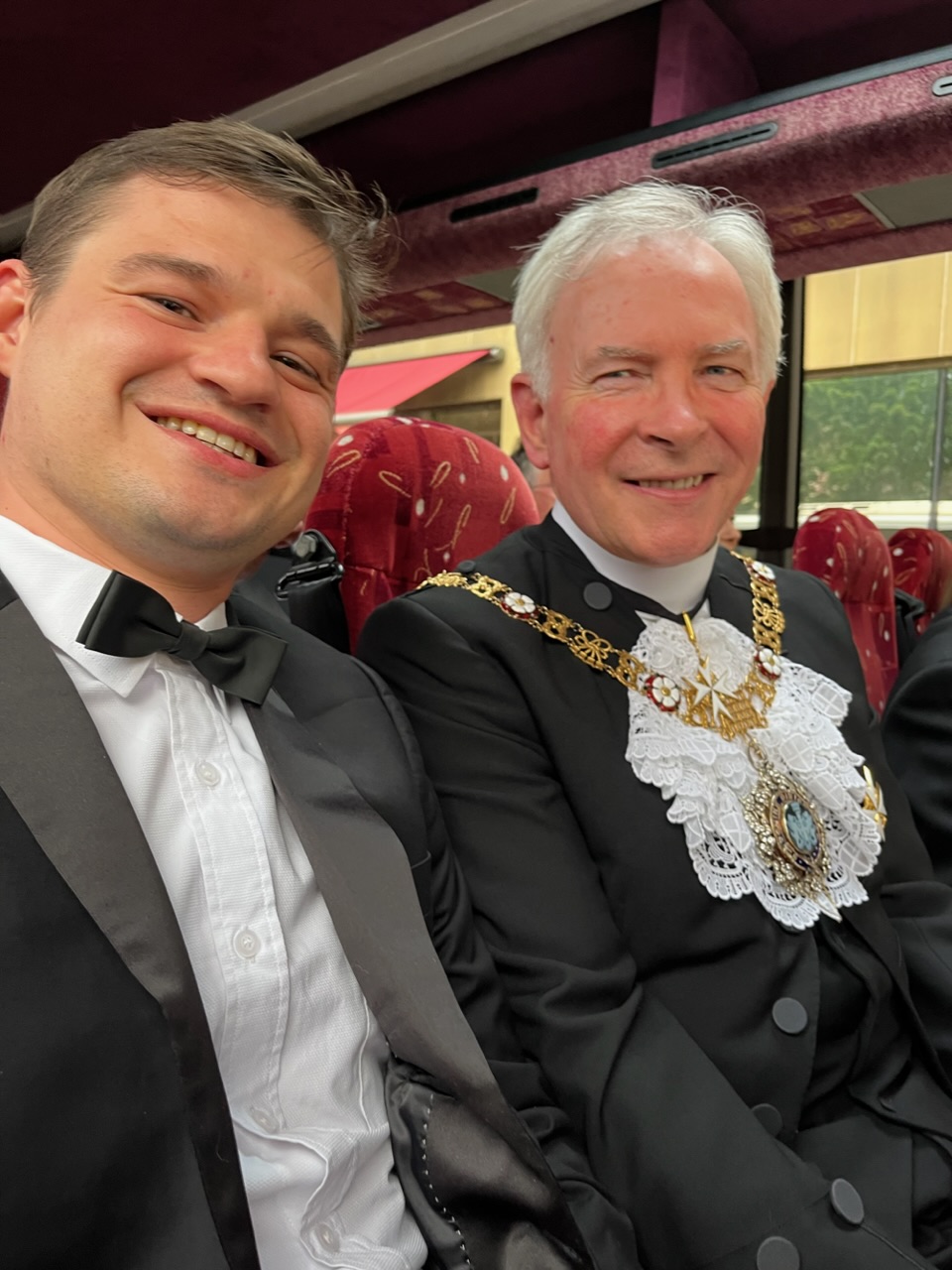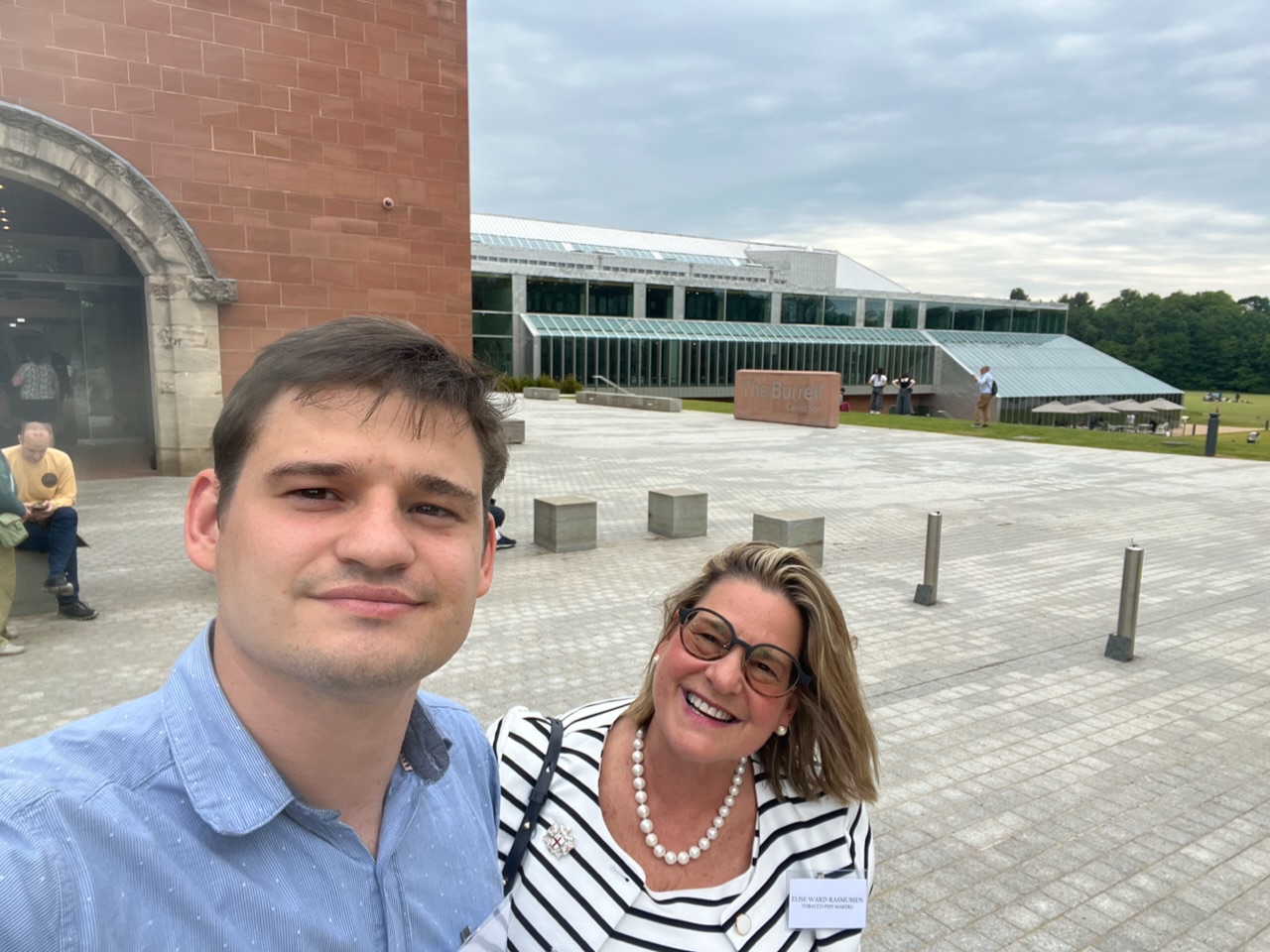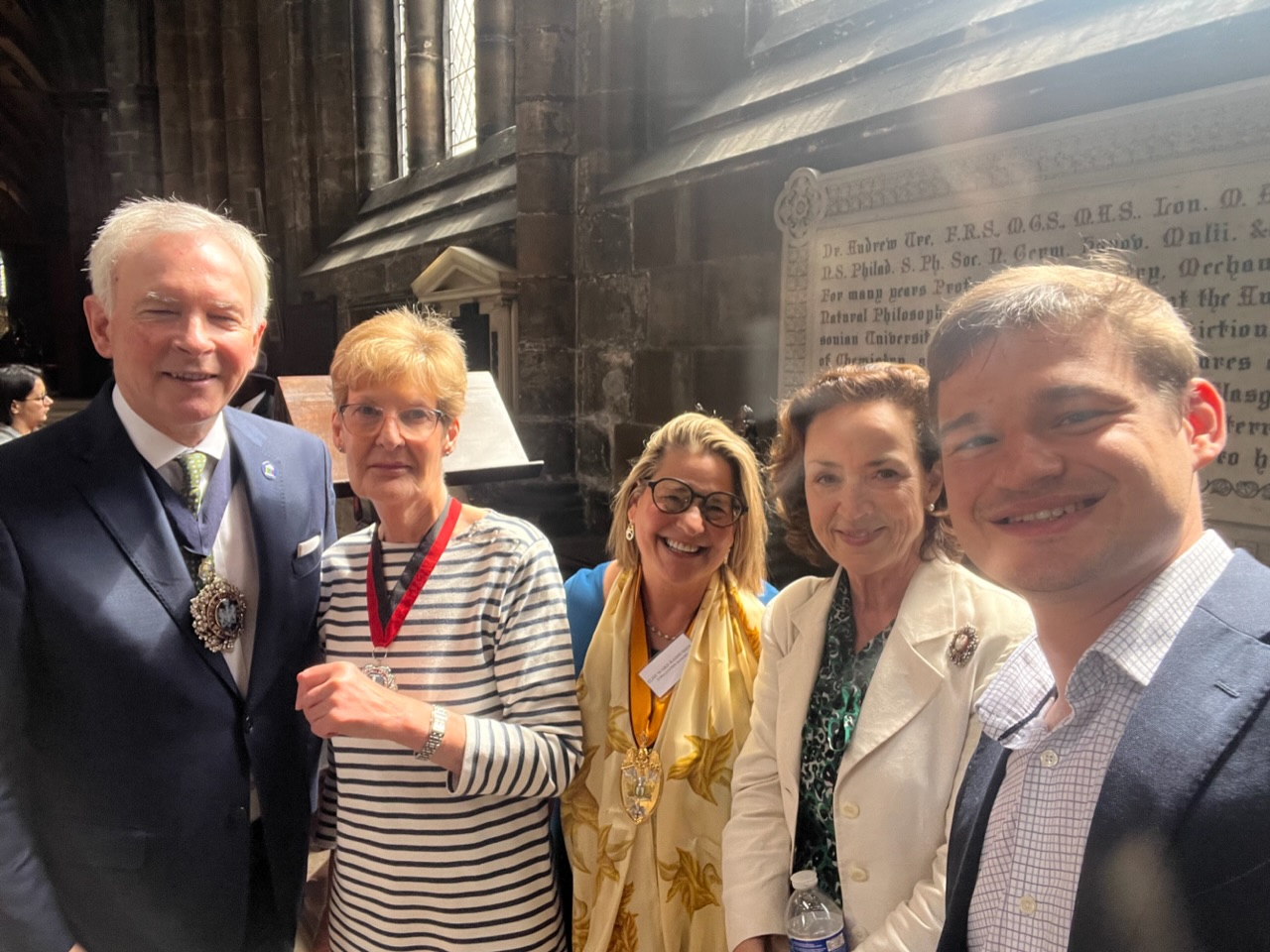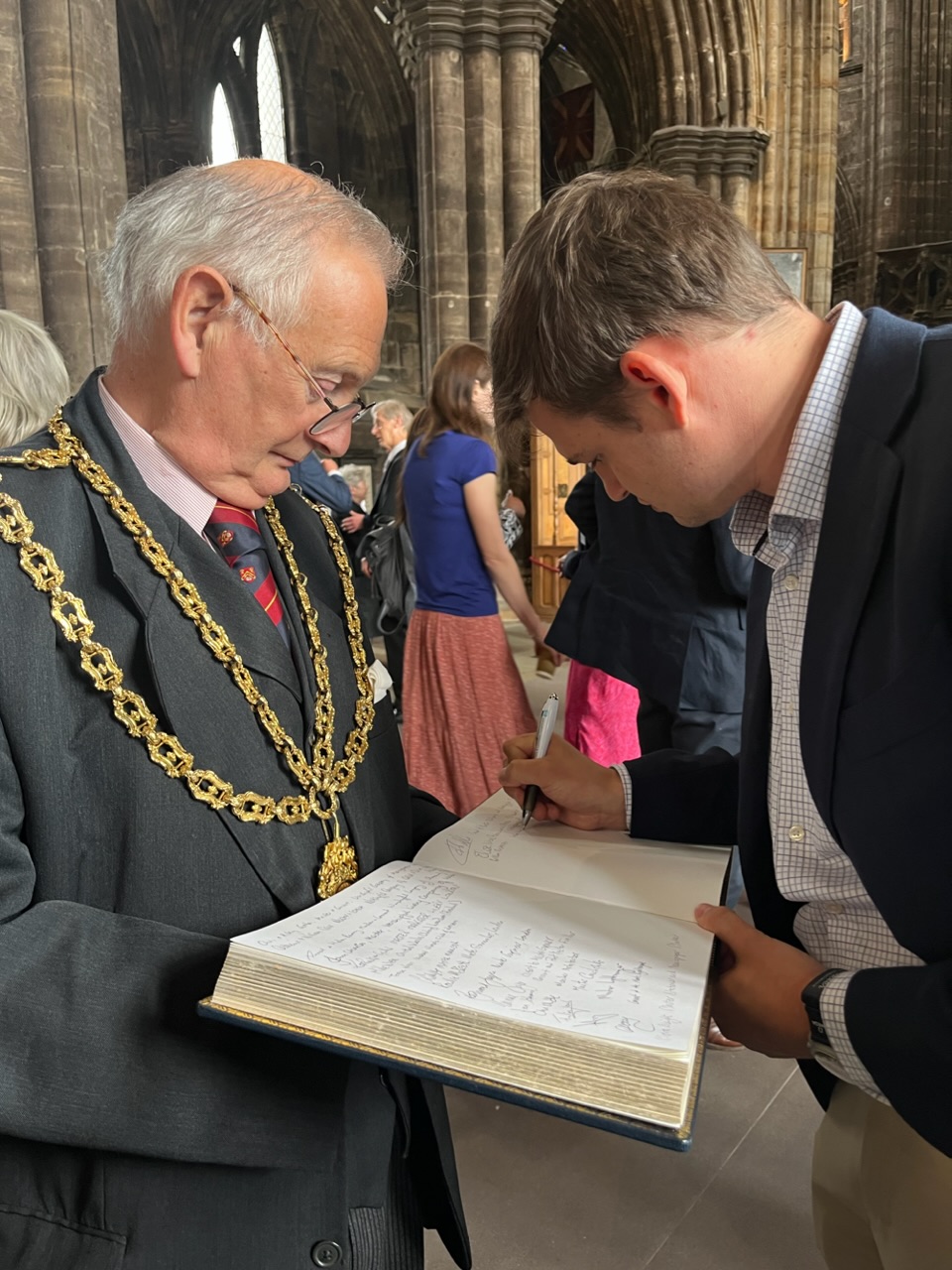Master’s Weekend Away with William Rasmussen
16th June 2023Glasgow
Failte
Failte means welcome in Scottish. Failte is how is all began on Friday afternoon June 9th, only two days after my Installation lunch. William, the Mistress, and I arrived at the Hilton Doubletree to a warm welcome and a cookie. The registration bag contained everything the 103 out of 111 Masters would need to know for our 48 hour whirlwind tour of Glasgow.
Bus 4, group 2 contained livery Masters from the end of the alphabet. As I was the ‘baby’ Master, I soon learned that a few others were old hands of several months while others were aging out of their post and Glasgow was a fitting last hurrah!
First stop was a reception and buffet supper at TRADES HALL OF GLASGOW
The home of the Trades House of Glasgow and the 14 Trade Incorporations, designed by Robert Adam, this is the second oldest building in the City still being used for its original purpose. It is an exquisite building divided into comfortable sized rooms that meant Masters and their Mistresses were separated out into their new groups to dine together and bond.
After supper the Hilton Doubletree Bar was the place to be as everyone gathered round to greet friends and make friends until last call.
Saturday morning bus 4 motored along until we reached the Mackintosh Queen’s Cross, a distinctive Mackintosh church created by Charles Rennie Mackintosh, Glasgow’s greatest architect, designer and artist. Small in size; but, architecturally significant, our specialist guide pointed out the nuances that made this building exceptional and one of Glasgow’ hidden architectural gems. A temporary installation of a Globe took Center stage and was a powerful reminder of the world at large.
Next stop was the tall ship, which could be found after one passed through the Transport Museum. The museum itself was so interesting that passing directly through it was impossible. Vehicles of every description and size were everywhere. VW vans and old trolley cars beckoned. I saw the first motor homes that contained as many amenities as modern ones do today. After craning my neck and racing down aisles, the back door opened to the magnificent tall ship, Glenlee of Glaswegians origin. Our enthusiastic guide gave us a history lesson, told stories and walked us around crew sleeping quarters as well as the officers quarters. I even rang the bell! Eventually we ambled our way downstairs to a sandwich buffet.
Time keeping what it is, we were marshalled back to bus 4 to journey outside of Glasgow amidst the trees and the woods, where the renown Burrell Collection is nestled. The Burrell Collection houses a staggering 9,000 objects including some of the most significant Chinese art in the UK, medieval treasures including stained glass, arms and armour, over 200 tapestries which rank amongst the finest in the world, and paintings by renowned French artists.
This collection was amassed by Sir William Burrell who bequeathed it to the City of Glasgow, provided it was housed in a countryside location. The current museum recently reopened after renovation. A specialist guide masterfully led us through the highlights of the collection, while William, who is far more knowledgeable about the collections than I, broke free seeking hidden gems as well as great Masters. Ultimately I had two distinct viewpoints and tours that made this visit even more memorable and unique! A ‘quick’ visit to the massive gift shop, led to the acquisition of an artistic kimono jacket as well as the requisite local whiskey!
As we made our way out of the forest back into the bustle of Glasgow itself, I was reminded that Glasgow is the most populous city in Scotland and the fourth most populous city in the United Kingdom, as well as being the 27th largest city by population in Europe.
Whiskey and Scotland are synonymous; so, what more fitting way to mark the end of our sightseeing frenzy than a civilised whiskey tasting hosted by the renowned whisky expert Richard ‘The Nose’ Paterson OBE. We learned to ‘greet’ our whiskey and make a proper acquaintance with it before sipping it and inhaling the distinctive aromas. A proper courtship was made between us and four of the most important Scottish whiskeys before our final bow to Richard Paterson and his team. Richard has written a book, which Amazon succinctly heralds as a triumph to the genre. (See below). Richard graciously signed copies before we left to prepare for our ‘gala’ dinner.
Richard Paterson has Scotch whisky running through his veins. His grandfather and father were both prominent in the Scotch whisky industry in Glasgow for decades before Richard joined a competing whisky brokerage firm to start his apprenticeship. But this is no dry textbook on blending. Far from it. Humour, insight, history, a love of people and an abiding and evangelical passion inform every page.For the first time one of the world's foremost whisky blenders reveals how he rose through the ranks to top of his profession. He also candidly reveals some of the secrets of his craft and gives his thoughts on where he feels the industry is heading today. Lavishly illustrated in colour and black and white with black and white line artwork, this is destined to become a whisky classic and an essential item on every whisky lover's bookshelf.
CITY CHAMBERS is a magnificent building and was built to demonstrate the great wealth and power of the City. Opened by Queen Victoria, its architecture inside is stunning with more marble than the Vatican. The evening started with a Reception hosted by the The Rt. Hon. The Lord Provost of Glasgow Jacqueline McLaren. Over champagne, ones eyes darted around capturing the light as it bounced from one majestic stone to another. The Banqueting Hall itself includes murals by several famous “Glasgow Boys” artists depicting Glasgow's past, present and future.
A popular fact is the relationship of the City Chambers to the film industry. The building was used as a stand in for the Kremlin in the film An Englishman Abroad in 1983 and as the Vatican in Heavenly Pursuits in 1986. It was also used for the film The House of Mirth in 2000 and featured more recently in the television series Outlander.
Theatrics played a part of our evening in this illustrious building as the haggis was piped in and a cleverly crafted ode was delivered. I really like haggis and must confess that this starter was my most memorable dish of the weekend.
The evening ended with a nightcap and last call at the Hilton Bar, as the Cathedral beckoned in the morning.
GLASGOW CATHEDRAL
The oldest building still being used for its original purpose. Glasgow Cathedral and St Magnus Cathedral in Orkney are the only medieval cathedrals in Scotland to have survived the Reformation virtually intact. It was saved from desecration by the tradesmen of the City. That is why it has a special place in the heart of the Trades House, with stained glass windows reflecting that connection. It is a place of immense history and hosted a special service on the Sunday morning.
William and I arrived early and were treated to a tour of the church and even managed a brief glimpse in the crypt. Regrettably the tour moved way too rapidly for me to take proper notes; so, I shall rely on the internet for the commentary:
The cathedral is dedicated to Saint Mungo, the patron saint of Glasgow, whose tomb lies at the centre of the building's Lower Church. The first stone cathedral was dedicated in 1136, in the presence of David . Fragments of this building have been found beneath the structure of the present cathedral, which was dedicated in 1197, although much of the present cathedral dates from a major rebuilding in the 13th century. Following its foundation in 1451, the University of Glasgow held its first classes within the cathedral's chapter house. After the Reformation, Glasgow Cathedral was internally partitioned to serve three separate congregations (Inner High, Outer High and Barony). The early 19th century saw a growing appreciation of the cathedral's medieval architecture, and by 1835 both the Outer High and Barony congregations had moved elsewhere in the city, allowing the restoration of the cathedral to something approaching its former glory.
A lunch of sandwiches and cakes fortified us in anticipation of our journey home. Planes, trains and automobiles were loaded with suitcases and mementos. We were all culturally enriched and grateful to our hosts and planners who shared a glimpse of their city and a slice of their life. It was a wonderful baptism by fire and an extraordinary introduction into what my year as Master will be like. Meeting so many incredible fellow Masters and their consorts was amazing and a true highlight. Their empathy and generosity was limitless.
Glasgow
William Topaz McGonagall
Beautiful city of Glasgow, with your streets so neat and clean,
Your stateley mansions, and beautiful Green!
Likewise your beautiful bridges across the River Clyde,
And on your bonnie banks I would like to reside.
Chorus --
Then away to the west -- to the beautiful west!
To the fair city of Glasgow that I like the best,
Where the River Clyde rolls on to the sea,
And the lark and the blackbird whistle with glee.
'Tis beautiful to see the ships passing to and fro,
Laden with goods for the high and the low;
So let the beautiful city of Glasgow flourish,
And may the inhabitants always find food their bodies to nourish.
Chorus
The statue of the Prince of Orange is very grand,
Looking terror to the foe, with a truncheon in his hand,
And well mounted on a noble steed, which stands in the Trongate,
And holding up its foreleg, I'm sure it looks first-rate.
Chorus
Then there's the Duke of Wellington's statue in Royal Exchange Square --
It is a beautiful statue I without fear declare,
Besides inspiring and most magnificent to view,
Because he made the French fly at the battle of Waterloo.
Chorus
And as for the statue of Sir Walter Scott that stands in George Square,
It is a handsome statue -- few with it can compare,
And most elegant to be seen,
And close beside it stands the statue of Her Majesty the Queen.
Chorus
And then there's the statue of Robert Burns in George Square,
And the treatment he received when living was very unfair;
Now, when he's dead, Scotland's sons for him do mourn,
But, alas! unto them he can never return.
Chorus
Then as for Kelvin Grove, it is most lovely to be seen
With its beautiful flowers and trees so green,
And a magnificent water-fountain spouting up very high,
Where the people can quench their thirst when they feel dry.
Chorus
Beautiful city of Glasgow, I now conclude my muse,
And to write in praise of thee my pen does not refuse;
And, without fear of contradiction, I will venture to say
You are the second grandest city in Scotland at the present day!
(C) William Topaz Mcgonagall
03/13/2017



